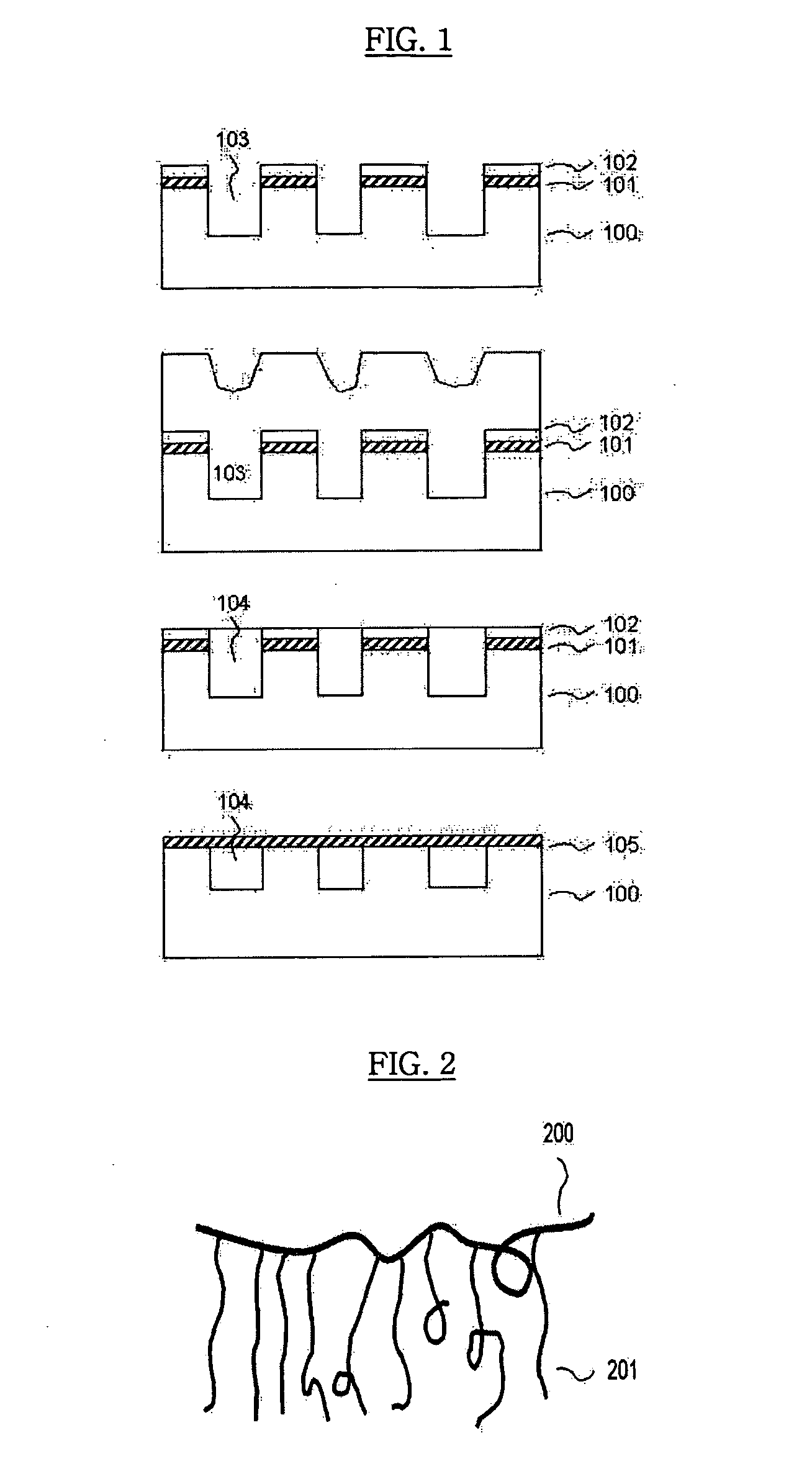Adjuvant for chemical mechanical polishing slurry
a technology of mechanical polishing and adjuvant, which is applied in the direction of polishing compositions with abrasives, chemistry apparatus and processes, and other chemical processes, can solve the problems of reducing the margin of subsequent steps for manufacturing a semiconductor device, reducing the polishing selectivity of the insulating silicon oxide layer to the sin layer, and reducing the polishing selectivity of the structure. , to achieve the effect of minimizing the agglomeration of abrasiv
- Summary
- Abstract
- Description
- Claims
- Application Information
AI Technical Summary
Benefits of technology
Problems solved by technology
Method used
Image
Examples
example 1
Preparation of Adjuvant for CMP Slurry
[0071] (Preparation of Macromonomer)
[0072] To a 500 mL four-neck flask equipped with a stirrer, thermometer, nitrogen gas inlet and a condenser, 75 parts by weight of isopropyl alcohol were introduced, and the mixture was bubbled with nitrogen at the reflux temperature for about 20 minutes. Next, 0.032 g of bis(boron difluorodiphenyl glyoxime)Co (II) was dissolved in 80 g of methyl ethyl ketone, and was added dropwide to the above reactor over approximately 270 minutes. Simultaneously with this, monomers containing 10 parts by weight of methacrylic acid and 90 parts by weight of hydroxyethyl methacrylate, and a polymerization initiator solution comprising 1 g of 2,2-azobis-2-methyl-butyronitrile dissolved in 49 g of isopropyl alcohol were added dropwise for about 240 minutes and 270 minutes, respectively. After the completion of the addition of the polymerization initiator solution, the reaction mixture was maintained at the reflux temperature...
example 2
Preparation of Adjuvant for CMP Slurry
[0080] (Preparation of Macromonomer)
[0081] A macromonomer was prepared in the same manner as described in Example 1.
[0082] (Preparation of Graft Type Polyelectrolyte)
[0083] To a 500 mL four-neck flask equipped with a stirrer, thermometer, nitrogen gas inlet and a condenser, 120 parts by weight of isopropyl alcohol, 30 parts by weight of the above macromonomer, 2.9 parts by weight of methyl methacrylate, and 7.1 parts by weight of acrylic acid were introduced, and the mixture was bubbled at the reflux temperature for about 10 minutes.
[0084] To the mixture, 0.2 parts by weight of t-amyl peroxy pivalate was introduced as an initiator, and monomers containing 17.2 parts by weight of methyl methacrylate and 42.8 parts by weight of acrylic acid, and 1.0 parts by weight of t-amyl peroxy pivalate were added dropwise over approximately 2 hours. Next, 0.3 parts by weight of t-amyl peroxy pivalate were added dropwise thereto over 10 minutes, and the r...
example 3
Preparation of Adjuvant for CMP Slurry
[0089] (Preparation of Macromonomer)
[0090] A macromonomer solution was obtained in the same manner as described in Example 1, except that 100 parts by weight of hydroxyethyl methacrylate were used instead of the monomers containing 10 parts by weight of methacrylic acid mixed with 90 parts by weight of hydroxyethyl methacrylate. The macromonomer obtained in this Example had a molecular weight of 1,000, a polymerization degree of 8, and a purity of about 96%.
[0091] (Preparation of Graft Type Polyelectrolyte)
[0092] To a 500 mL four-neck flask equipped with a stirrer, thermometer, nitrogen gas inlet and a condenser, 120 parts by weight of isopropyl alcohol, 30 parts by weight of the above macromonomer, 4.3 parts by weight of methyl methacrylate, and 5.3 parts by weight of acrylic acid were introduced, and the mixture was bubbled at the reflux temperature for about 10 minutes.
[0093] To the mixture, 0.2 parts by weight of t-amyl peroxy pivalate ...
PUM
| Property | Measurement | Unit |
|---|---|---|
| wt % | aaaaa | aaaaa |
| wt % | aaaaa | aaaaa |
| weight | aaaaa | aaaaa |
Abstract
Description
Claims
Application Information
 Login to View More
Login to View More - R&D
- Intellectual Property
- Life Sciences
- Materials
- Tech Scout
- Unparalleled Data Quality
- Higher Quality Content
- 60% Fewer Hallucinations
Browse by: Latest US Patents, China's latest patents, Technical Efficacy Thesaurus, Application Domain, Technology Topic, Popular Technical Reports.
© 2025 PatSnap. All rights reserved.Legal|Privacy policy|Modern Slavery Act Transparency Statement|Sitemap|About US| Contact US: help@patsnap.com

